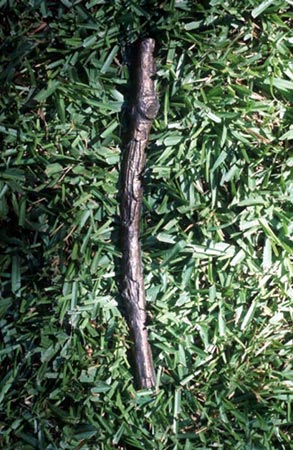<<

{click on image to view more}
Kindling
Smoky Hill River Festival
Salina, Kansas, June 12-14, 1998
"...for it is when art acts as an agent of transformation that
we may correctly speak of it as a gift." –The Gift, by
Lewis Hyde
As I considered the Salina Art Center's invitation to create a temporary
public sculpture for the 1998 Smoky Hill River Festival, I began
to see the opportunity for an experiment in hidden art. Rather than
presenting festival-goers with the expected – an object to
be stood before and beheld – I thought it would be more interesting
to challenge them with the subtle and unexpected. I knew from the
beginning that the idea involved some risk, but I was heartened
by my past experiences in Salina. The generous and knowing response
of the Art Center's audience to an earlier exhibition of mine encouraged
me to take a chance.
The idea was to scatter one thousand cast bronze sticks throughout
the festival grounds. Anyone who found one could keep it. I thought
of the bronze stick as working on several different levels. On one
level it served as a game piece in a massive treasure hunt. On another
it might serve as a memento of this year's festival. As a component
in an artwork, I thought of it as functioning on both an actual
and a symbolic level. I saw it as a physical token of what is normally
an abstract exchange between artist and audience. My intent was
to present the opportunity for a momentary reenchantment with the
ordinary and at the same time to provide a souvenir of that experience.
The title Kindling refers not only to the physical likeness
of the project's elements to dry sticks of wood used to start a
fire but also to one of the definitions of the verb kindle: "to
arouse or inspire." With the title I wanted to acknowledge
my own belief in the power of art to transform and also to express
my wish that this particular work might possess a small portion
of that power.
Bonded sand was used to form molds from one thousand actual sticks
gathered and trimmed to a length of nine inches, a size chosen for
comfort and portability. Each unique casting weighed about six ounces.
Because I felt that the element of surprise was an important aspect
of the project, the bronze sticks were given an antique patina so
that the replicas would blend with the natural litter under the
trees and along the riverbank of Oakdale Park. Sensitive to the
project's unusual requirements for furtiveness, the festival staff
issued deliberately ambiguous publicity for Kindling. Preview
materials for the project read: "Art is everywhere in the park
this year. Find it and it is yours forever." In the studio,
as I pressed the still-plastic sand up against each original or
held each raw casting against the grinding wheel, I often thought
about the anonymous hands that would complete the process.
The bronze sticks were scattered throughout the park early in the
morning before the crowds arrived. They were placed where twigs
might normally fall or accumulate. Some were laid in open areas
where even the right turn of sunlight on metal might offer a clue,
while others were tucked away in more challenging spots under bushes
or in tall grass. My hope was that someone would stumble upon one
of these curiosities and that, once the secret presence was discovered,
word-of-mouth would launch a communal treasure hunt. I worried for
a while, fearing that none would be discovered. But before long
my concern was eased by the sight of people meandering along the
riverbank with their heads down. As time passed, the rumor of the
bronze sticks became as much a part of the festival as the games,
the music, and the food. I was relieved and delighted as I observed
solitary seekers, families, and bands of teenagers combing the grounds
for hidden treasure. The festival staff's fear that some sticks
would remain as booby traps for the park's lawnmowers was allayed
by the sight of children and adults crawling under shrubbery in
search of metallic booty.
A picture is worth a thousand words. The photograph of the smiling
young girl wearing a LUCKY tee shirt and holding a bronze stick
is my own souvenir of Kindling. Like most artists, I usually
do not know on a personal level how my work is received. Once we
let our creations go, we can only hope that our work will grant
a moment of amusement or wonder or escape or maybe even prompt some
small change in attitude or reawakening of spirit. For me the pleasure
of the project was being able to witness in anonymity the reaction
of an audience to my work.
Set free during a weekend in June, each object has now begun its
own individual history. Some will be treasured, and some forgotten.
Some will be lost forever, and some refound. In retrospect I consider
the possibilities. Does one serve as a paperweight? Is one lost
already in the darkness at the back of a drawer? Has one been generously
passed on to another and in turn passed on again? Does one sit proudly
on a mantle, the warmth of the fire inducing a vague remembrance
of its origin? I'm reminded of the old saying that firewood warms
you twice, once when it's gathered and once when it's burned. I
wonder if the immediate surprise and joy of finding an unusual stick
on a hot summer afternoon will be rekindled now and again by these
gifts I offered.

<<
|